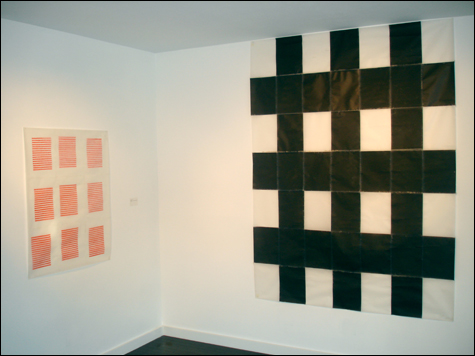
LAST COLOR: "Untitled," 2006. |
| Jared Radding | at Franklin Street Art Space, 41 Franklin St, Biddeford | through Feb 29 | 207.229.3560 |
Recent Nevada transplants Tammy Ackerman and Russell Persson are riding the wave of rejuvenation taking shape in Biddeford. Their new gallery and performance space, the Franklin Street Art Space has the potential to make that wave even bigger.Located in the dilapidated but charming downtown of Biddeford, the newly renovated space is just large enough to present a small scope of work. Last week, the space hosted an event with Portland troubadour Chriss Sutherland, resulting in a hopefully-more-frequent evening of Biddeford and Portland crowds mingling with music and visual art.
Providing the gallery’s third show, Jared Radding maintains a monochromatic exploration while managing to skirt obsession. Each work, despite the predominance of formal arrangements in black and white, remains loose and playful. The risk in Radding’s approach is a first impression of sloppiness. Transparent tape traps dirt between tiled sheets of tracing paper callously stapled into the gallery wall.
Furthermore, Radding’s habit of rapid execution raises the question of whether he understands the potential irony in adding rough edges and personality to a body of work which falls in a tradition attempting to distance the artist from the art. His five discrete ideas, some involving multiple works, give just enough breadth of concept so the viewer can trace a quick chronology of the artist’s development. This suggests just such an art-historical awareness, delivered with middle finger extended to Clement Greenberg et al.
The oldest piece in the show, “Untitled” from 2006, is the only one with color. Solid horizontal red bars are evenly spaced on a sheet of tracing paper and then serialized into a 3x3 grid with transparent tape. The uniformity is broken with blatantly visible strokes from a red permanent marker and an uneven placement of the blocks of bars on each page.
This older piece is Radding’s point of departure for the rest of his displayed work. A much larger painting, also untitled and from last year, utilizes a similar grid system. Formal color relations are now equally spaced, as each small sheet of denril material is left white or spray-painted black. The masking tape holding this patchwork together is nothing short of disgusting. Finger marks cover the black and make glaring reflections under the scrutiny of the gallery lights. A perfect geometrical relation is rendered as an impossible endeavor. A human hand was present.
Radding’s next refinement follows with a series of three 9x12 denril sheets, now almost entirely blacked out with acrylic. The material almost rejects the paint, soliciting the artist to layer the compositions several sheets thick so that layers of visible brushstrokes add density. The line is unclean and the brushstrokes are soothing, negating the black void.
The culmination are four untitled white-on-white pieces. Sheets of Mylar and drafting paper are layered this time with visceral brushstrokes of white acrylic emerging from large fields of tone, cut with oblique boundaries. The work looks elegant from ten paces back, like earnest meditations on ephemerality, but closer inspection reveals Radding’s trademark grime.
Whether Jared Radding’s current body of work is successful seems more a matter of concept than quality. Should this young artist continue to develop his informal approach, and we hope he will continue to eschew the “fine” in fine arts, we can expect more intelligent explorations.
Ian Paige can be reached at ianpaige@gmail.com.